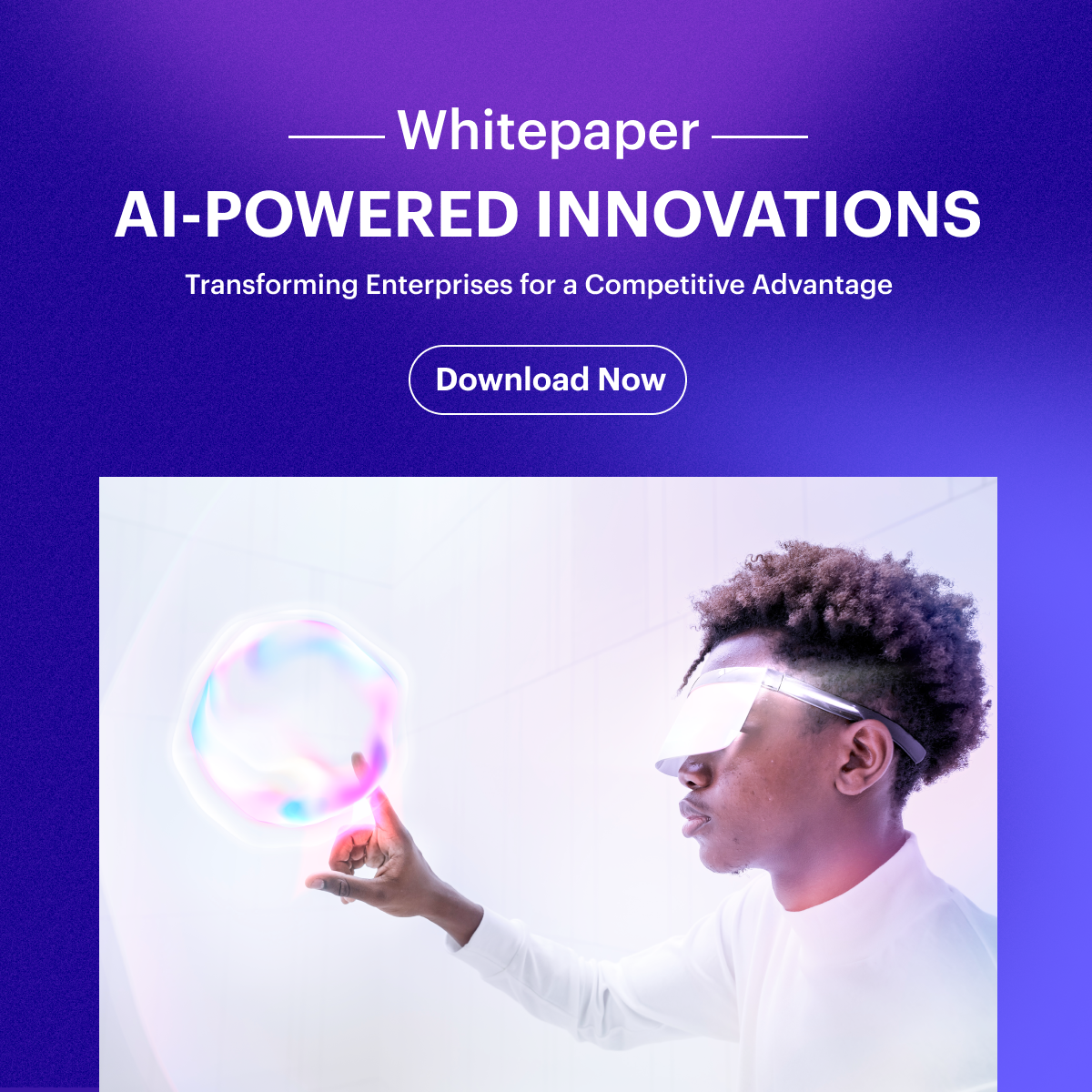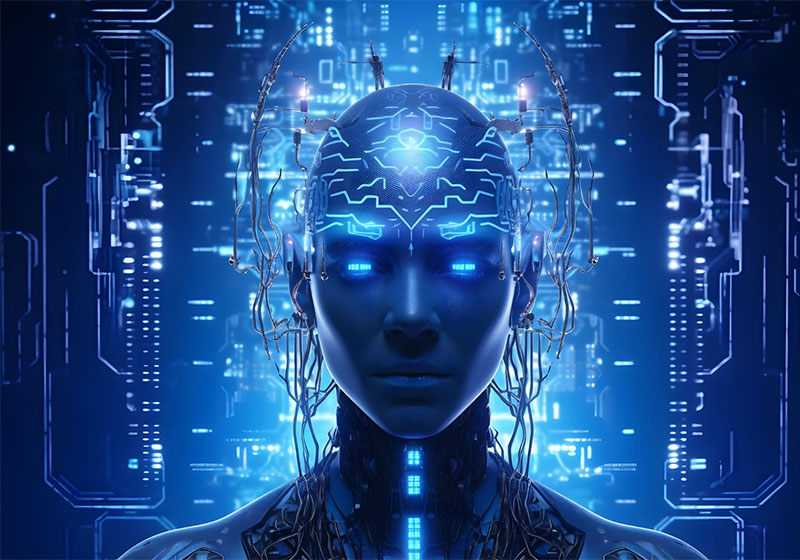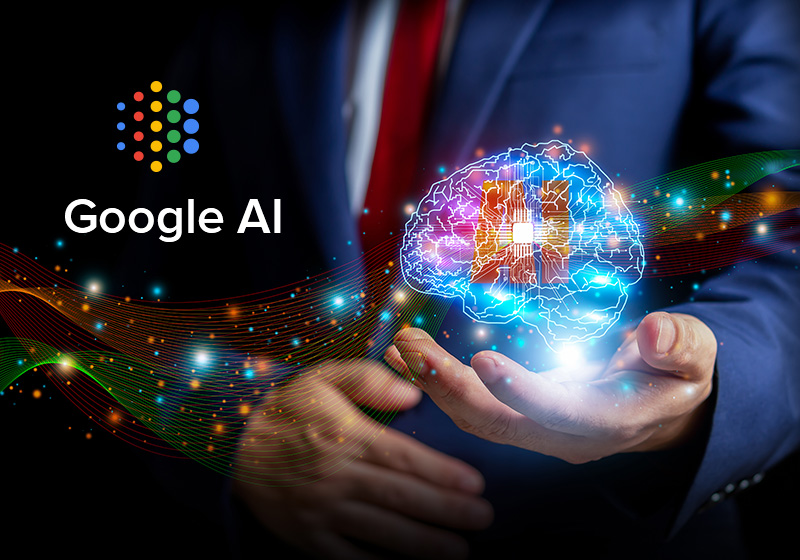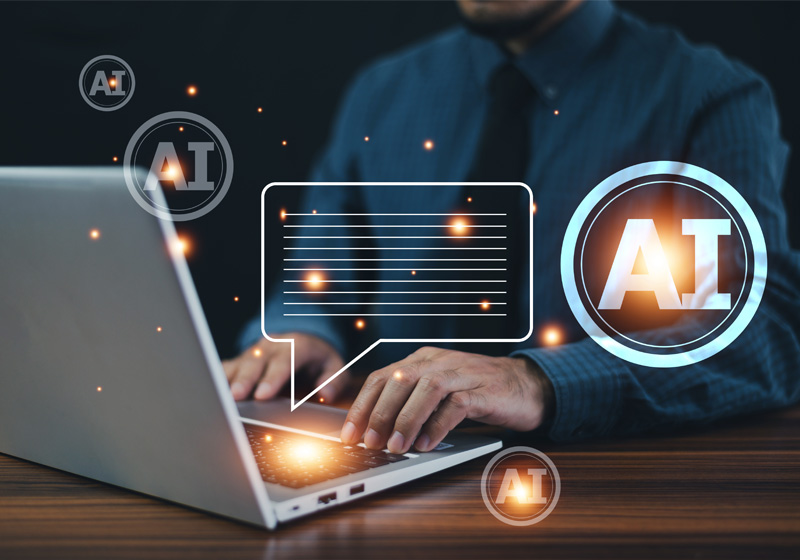Generative AI
How Generative AI Development is Transforming Diverse Industries
 Updated 06 Jun 2024
Updated 06 Jun 2024
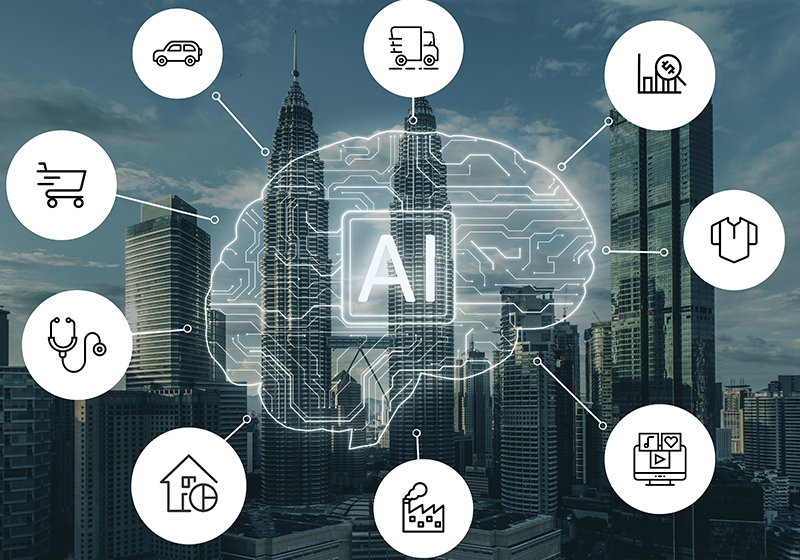
Generative Artificial Intelligence can be said to be a transformative field of AI that is focused on the creation of fresh content, data, or outputs that look as if they have been created by humans. AI systems generally focus on problem-solving and pattern recognition, but generative AI takes this a level ahead. It enables machines to independently generate fresh content. Basically, generative AI makes use of huge datasets, a variety of advanced algorithms, and deep learning models to understand patterns, learn from past mistakes, and create fresh content with characteristics from the training data.
In 2014, Ian Goodfellow and his associates presented a method in generative AI called Generative Adversarial Networks (GANs). The GAN basically comprises a generator and a discriminator neural network, which takes part in a competitive learning process. The discriminator assesses the reliability of the artificial data samples—such as text or images—that the generator produces. The generator gains the ability to generate outputs that are more realistic through recurring training, while the discriminator advances its ability to distinguish between actual and deceptive data.
Another notable method within generative AI is Variational Autoencoders (VAEs). These systems function by acquiring a probabilistic understanding of how data in a high-dimensional space corresponds to a lower-dimensional latent space and, subsequently, reconstructing it back to its original form. VAEs excel in grasping the fundamental distribution of input data and producing fresh samples based on this distribution.
In a survey conducted on 4000 full-time workers from various industries such as sales, services, IT, marketing etc. on their perspective on generative AI revealed that 73% of Indian population, 49% of Australian population, 45% of US population and 29% of UK population is using generative AI. Another reliable statistics states that generative AI improves employee productivity by up to 66%.
Applications for generative AI can be found in many different fields such as science, literature, art, music and design. It has helped advance creative fields by creating original music, convincing human-like text and realistic images. Additionally, generative AI is being used more and more in real-world applications such as content creation and data augmentation, drug discovery and more.
Let us understand more about the uses and applications of generative AI across various industries and learn about some popular generative AI tools:
Generative AI capabilities
Generative AI capabilities are transforming the landscape of technology and creativity. By harnessing advanced algorithms, these systems can autonomously generate text, images, audio, and more, offering many possibilities across various industries. This technology is reshaping how we approach content creation, problem-solving, and innovation. Here are some areas in which generative AI is extremely helpful:
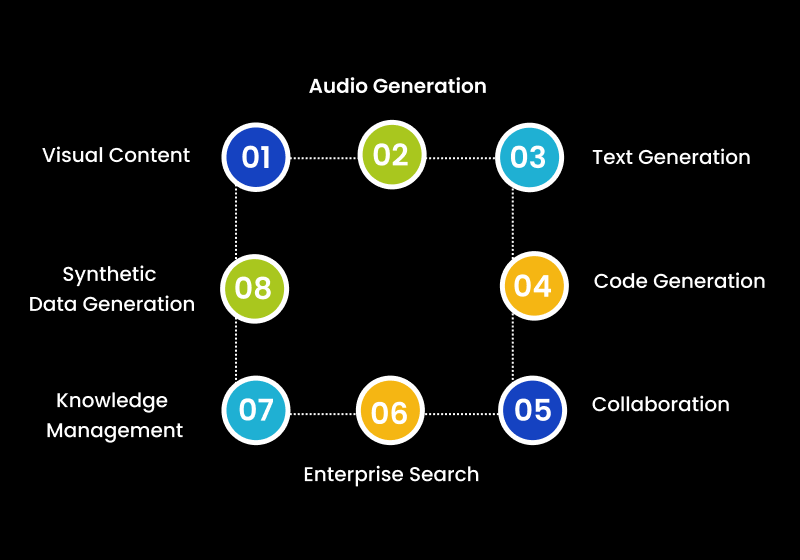
1. Visual Content
Generative AI is employed in generating visual content such as images and videos. These models can create realistic images from textual descriptions, enhance low-resolution images, 3D shape generation and even generate entirely new artwork based on given parameters. Applications include content creation for marketing, design prototyping and virtual environments in gaming and entertainment.
2. Audio Generation
In the realm of audio, generative AI services can synthesize lifelike speech, music, and sound effects. It enables the creation of natural-sounding voice assistants and personalized music playlists and even generates background scores for videos or games. Speech-to-speech conversion and text-to-speech conversion is also possible with generative AI. Professionals from the movie industry and the gaming industry can create voiceovers in no time using the STS conversion. This technology finds applications in entertainment, accessibility tools, and voice-based interfaces.
3. Text Generation
Text generation models powered by generative AI development can produce coherent and contextually relevant text based on prompts. These models are used in applications such as chatbots, ChatGPT, content creation, and language translation. They can automate customer service interactions, generate news articles, and assist writers in generating ideas or drafts.
4. Code Generation
Generative AI development is transforming software development by automating code generation, thereby reducing the need for manual coding. These models save developers considerable time and effort in writing, testing, and debugging code. Key functionalities include code completion, where AI models like ChatGPT analyze the context to suggest the next line of code, and code generation, which uses natural language processing to convert text prompts into functional code snippets. Additionally, generative AI can automatically generate test cases to verify software functionality, identify and fix bugs, and facilitate the swift integration of machine learning models, for example decision trees or neural networks into software.
5. Collaboration
Generative AI development services facilitate collaboration by providing tools for brainstorming, idea generation, and content creation. These tools can assist teams in generating visualizations, presentations, and project plans based on input from multiple stakeholders. They enhance teamwork, develop creativity, and streamline communication in distributed or remote work environments.
6. Enterprise Search
In enterprise settings, generative AI powers advanced search capabilities that can understand natural language queries and retrieve relevant information from vast repositories of data. These systems enable users to quickly find documents, reports, or insights within organizational databases and improve productivity and decision-making.
7. Knowledge Management
Generative AI supports knowledge management by automatically summarizing documents, extracting key insights, and organizing information in structured formats. These systems aid in creating knowledge bases, training materials, and documentation repositories, as well as facilitate knowledge sharing and retention within organizations.
8. Synthetic Data Generation
Generative AI is significant in creating synthetic datasets for training machine learning models. These datasets simulate real-world scenarios and diverse data distributions and help overcome the limitations of insufficient or biased training data. Synthetic data generation accelerates model development, improves performance, and ensures robustness in AI applications.
Read Our Case Study: Enhancing Customer Engagement With A Product Recommendation Chatbot Assistant For A Leading Cosmetics Chain
Generative AI Use Cases and Applications Across Industries
Generative AI is revolutionizing various industries by providing innovative solutions and enhancing operational efficiency. Its applications span multiple sectors, including:
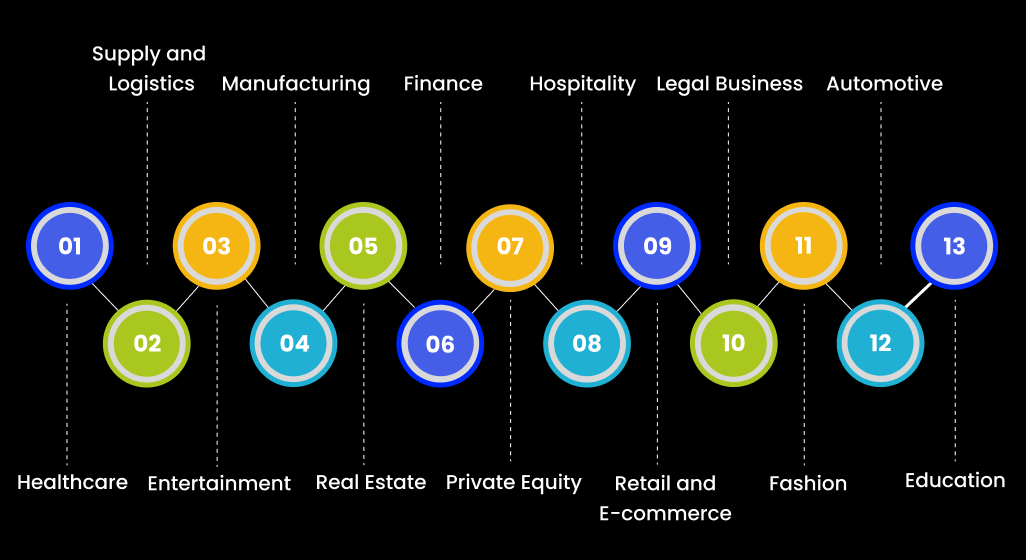
1. Healthcare
Generative AI is significantly advancing healthcare by aiding in drug discovery, analyzing medical images, and personalizing treatment plans. It can generate synthetic medical data for research purposes, design new molecules for pharmaceutical development, and improve diagnostic accuracy, which helps in better patient outcomes and innovative medical solutions.
2. Supply and Logistics
Generative AI development is transforming supply chain and logistics management by optimizing route planning, inventory management, and demand forecasting. It can generate predictive models that anticipate disruptions, suggest alternative routes, minimize delays, and lower transportation costs.
In warehousing, AI-driven robots and systems enhance the efficiency of sorting, packing, and shipping processes. By analyzing historical data, generative AI can predict inventory needs and automate restocking to ensure that products are available when needed and reduce excess stock. Additionally, it helps in optimizing supply chain networks, improves overall operational efficiency, and enhances the ability to respond swiftly to market changes.
3. Entertainment
Generative AI is transforming the entertainment industry by enabling the creation of hyper-realistic animations, synthesizing new music, and enhancing visual effects in films and video games. It can also generate unique storylines, character designs, and even entire scripts and offers endless possibilities for creative content and immersive experiences.
4. Manufacturing
In manufacturing, AI-driven design and optimization tools help create efficient product designs and enhance production processes. Generative AI facilitates predictive maintenance, reduces downtime, and optimizes supply chain operations, which helps increase productivity and cost-effectiveness in manufacturing environments.
5. Real Estate
Generative AI development has transformed the real estate industry with realistic property simulations and virtual tours, aiding buyers and renters in making informed decisions. It assists in property valuation, market trend analysis and generates personalized property recommendations. This allows streamlining the real estate transaction process.
6. Finance
In the financial sector, generative AI models are pivotal for algorithmic trading, risk management, and fraud detection. Through analyzing vast amounts of financial data, these models can generate insights, forecast market trends, and automate complex decision-making processes, which help enhance efficiency and accuracy in financial operations.
7. Private Equity
In private equity, generative AI analyzes market trends, financial reports, and business models to identify potential investment opportunities. It assists in due diligence processes, portfolio management, and performance forecasting and helps in decision-making and investment strategies.
8. Hospitality
In the hospitality industry, generative AI personalizes guest experiences, optimizes room pricing, and predicts maintenance needs. It analyzes guest feedback for sentiment analysis, enhances staff scheduling based on demand forecasts, and improves overall operational efficiency, which enhances guest satisfaction.
9. Retail and E-commerce
Generative AI personalizes shopping experiences through customized product recommendations, dynamic pricing strategies, and accurate demand forecasting. It enhances visual search capabilities, optimizes inventory management, and improves customer service by analyzing consumer behavior and preferences.
10. Legal Business
AI models streamline legal processes by automating document analysis, contract generation, and legal research. Predictive analytics help assess case outcomes, monitor compliance, and manage legal risks. This enhances efficiency and reduces the workload for legal professionals.
11. Fashion
In the fashion industry, generative AI development services helps design unique textiles, create personalized shopping experiences, and optimize supply chains. It enables virtual try-ons, generates sustainable design solutions, and predicts fashion trends, which enhances creativity and sustainability in fashion design and retail.
12. Automotive
Generative AI aids in designing and optimizing vehicle components, simulating driving scenarios, and developing autonomous driving systems. It predicts maintenance needs, optimizes the supply chain, and enhances vehicle safety and performance through advanced analytics and real-time data processing.
13. Education
Generative AI customizes educational content to individual learning styles, automates grading, and creates intelligent tutoring systems. It designs adaptive assessments, generates realistic virtual laboratories for interactive learning experiences and provides personalized feedback to improve educational outcomes.
Read Our Case Study: Revitalizing Sales Enablement With An AI-Powered Chatbot For A Leading FMEG Company
How to Implement AI for Maximum Impact in Any Industry?
Implementing AI for maximum impact involves a strategic and meticulous approach.
- Identify Business Objectives – Begin by defining clear objectives that align with the organization’s goals and challenges. This step involves understanding the specific problems or opportunities where AI can make a major impact and categorizing key performance indicators (KPIs) to measure success.
- Select AI Technologies—Based on the identified objectives and challenges, choose appropriate AI technologies. Consider factors such as the nature of the problem, the availability of data, and the team’s expertise. Common AI technologies include machine learning, deep learning, natural language processing, and computer vision.
- Data Collection and Pre-processing—Gather high-quality, relevant data from various sources, such as internal databases, third-party sources, and sensor data. Pre-process the data to ensure accuracy, completeness, and consistency. Remove noise and, if necessary, correct missing values.
- Model Selection and Training – Choose the right AI models based on the problem at hand and the available data. Train these models using robust techniques such as cross-validation, hyperparameter tuning, and transfer learning to optimize their performance. Evaluate the models using appropriate metrics and validation techniques to ensure they generalize well to new and unseen data.
- Deployment and Integration – Deploy the trained AI models into production environments and integrate them seamlessly with existing systems and workflows. Check the compatibility with other software and hardware components and establish proper data pipelines for real-time or batch processing.
- Monitoring and Maintenance – Uninterruptedly monitor the performance of the deployed AI models to detect any issues or anomalies. Implement monitoring tools and alerting mechanisms to notify stakeholders of potential problems. Regularly update and maintain the models to keep them accurate and up-to-date with changing data and business requirements.
- Ethical Considerations and Compliance – Address ethical considerations and compliance requirements throughout the AI implementation process. Ensure transparency, fairness, and accountability in AI systems and mitigate potential biases and privacy concerns. Follow the relevant regulations and industry standards to avoid legal and regulatory risks.
- Stakeholder Education and User Training – Educate stakeholders and end-users about the AI system to ensure they understand its capabilities, limitations, and potential impact on their roles and workflows. Provide training and support to help users effectively interact with and benefit from the AI system.
- Documentation and Knowledge Sharing – Document the AI implementation process thoroughly, including data sources, model architectures, training procedures, deployment configurations and performance metrics. Share knowledge and best practices within the organization to facilitate collaboration and continuous improvement.
Generative AI Models
Generative AI models are specialized algorithms designed to create new content by learning from existing data. Prominent examples include Generative Adversarial Networks (GANs) and Variational Autoencoders (VAEs). GANs consist of two neural networks, the generator, and the discriminator, that work in tandem. The generator creates new data samples while the discriminator evaluates their authenticity, leading to highly realistic content generation over time.
VAEs, on the other hand, learn a probabilistic plotting from a high- dimensional input space to a lower dimensional latent space and then back to the original space. This capability allows VAEs to capture the underlying distribution of input data and create new samples that resemble the training data. VAEs are particularly effective for tasks requiring diverse and high-quality content generation, such as image synthesis and data augmentation.
These generative models have extensive applications across various fields, from creating realistic images and videos to generating text and audio content. They are invaluable in creative industries, virtual reality, and natural language processing, where the capability to produce new and high-quality content is essential. As generative AI technology continues to advance, its applications are expected to expand and offer even more sophisticated and versatile solutions.
AI Tools that Offer Immense Potential for Your Business
While we are all familiar with generative tools like Chat GPT, Bard by Google, and Dall E., there are many more that have been helping various industries. Some of the tools are as follows:
- DeepArt.io – DeepArt.io is a platform that uses neural networks to transform photos into artworks in various styles, such as famous paintings or abstract designs. Users can upload their images and apply a range of artistic filters to their photos.
- Artbreeder – This is an online platform that help users create new artwork by blending and evolving existing images. It uses generative adversarial networks (GANs) to generate unique and surreal images based on user inputs and preferences.
- RunwayML – RunwayML is a creative toolkit that enables artists and designers to experiment with AI models for various creative tasks. It offers access to a range of pre-trained models for tasks like image generation, style transfer, and text-to-image synthesis.
- Duet AI – This is a cutting-edge platform that harnesses the power of generative artificial intelligence to enable virtual collaboration between human performers and AI-generated avatars. This innovative technology let users to create stunning music videos featuring lifelike virtual performers who can play musical instruments and synchronize their performances with real musicians.
- Dreamscope – Dreamscope is an app that uses deep learning algorithms to transform photos into artistic images inspired by famous artists and art styles. Users can apply a broad range of filters and settings to customize the appearance of their images.
- Cohere Generate is another noteworthy tool in the realm of generative AI, offering advanced capabilities for natural language processing and content generation. Leveraging state-of-the-art language models, Cohere Generate enables users to generate high-quality text content across various domains, including articles, product descriptions, and marketing copy. With its ability to comprehend context and generate coherent and contextually relevant text, Cohere Generate is revolutionizing content creation processes, empowering businesses to produce engaging and informative content efficiently.
- Deep Dream Generator – It is a web-based tool that uses deep learning algorithms to generate surreal and dream-like images from ordinary photos. Users can upload their images and apply a broad range of visual styles and settings to their photos.
- Claude – Claude is a generative AI tool designed specifically for creating digital art. It allows users to manipulate digital images using AI algorithms, enabling them to experiment with different styles, colours and compositions to create unique and visually striking artwork.
- GitHub Copilot – This AI-powered tool is developed by GitHub in collaboration with OpenAI. It operates as an advanced code completion system and provides developers with intelligent suggestions and auto-completions as they write code within their Integrated Development Environments (IDEs). By leveraging the vast code repositories on GitHub and OpenAI’s GPT technology, GitHub Copilot can generate code snippets, functions, and even entire methods based on the context and necessities provided by the developer. This revolutionary tool significantly boosts developer productivity, streamlines the coding process, and accelerates software development cycles.
Advantages of Generative AI Across Various Industries
Generative AI services offer several advantages across various domains, revolutionizing industries and redefining what is possible. Here is a closer look at the key advantages of generative AI across different sectors:
1. Enhanced Creativity and Innovation
Generative AI empowers individuals and organizations to explore new creative frontiers by generating unique and innovative content autonomously. Whether producing original artwork, designing novel products, or composing music, it fosters creativity and innovation by offering fresh perspectives and generating ideas that might not have been conceived otherwise.
2. Operational Efficiency
Across industries, generative AI development services streamlines workflows and automates repetitive tasks, thereby enhancing operational efficiency. By automating processes such as content generation, data analysis, and optimization, generative AI frees up valuable human resources and allows organizations to focus on high-value tasks and strategic initiatives. This increased efficiency leads to cost savings, faster time-to-market, and improved competitiveness.
3. Personalization and Customer Experience
Generative AI enables hyper-personalized experiences by leveraging data to tailor content, recommendations, and interactions to individual preferences and needs. Whether it is personalized product recommendations in retail, customized learning experiences in education, or adaptive user interfaces in technology, generative AI enhances customer satisfaction, fidelty, and engagement by delivering relevant and meaningful experiences.
4. Data Insights and Decision-Making
Generative AI development provides valuable insights and predictive capabilities by analyzing huge amount of data and recognizing patterns, trends, and correlations. By leveraging these insights, organizations can make data-driven decisions, optimize processes, and anticipate future trends and opportunities. From predictive analytics in finance to demand forecasting in supply chain management, it empowers organizations to make informed decisions that help in business growth and success.
5. Content Quality and Consistency
Generative AI ensures consistent quality and coherence across content generation tasks, whether it is writing articles, composing music, or designing visuals. Maintaining a consistent style, tone, and level of sophistication helps organizations uphold their brand identity, strengthen their messaging, and establish credibility with their audience. This consistency is particularly valuable in marketing, branding, and content creation, where maintaining a cohesive brand image is essential.
6. Automation and Scalability
Generative AI enables automation at scale, allowing organizations to handle complex tasks efficiently and effectively. Automating customer support with chatbots, generating synthetic data for training machine learning models and or automating routine administrative tasks are some features offered by generative AI which accelerates processes, reduces manual effort and scales operations to meet growing demand.
7. Ethical Considerations and Responsible AI
Despite its transformative potential, generative AI raises ethical considerations related to privacy, bias, and misuse. Organizations must prioritize responsible AI practices, including transparency, fairness, and accountability, to mitigate potential risks and ensure ethical deployment. By addressing these concerns proactively, organizations can build trust with stakeholders, uphold ethical standards, and harness the full potential of generative AI for positive impact across domains.
Where to Avail Generative AI Services?
With Q3 technologies organizations can harness the power of generative AI so they can unlock new opportunities, welcome innovation and reshape the future of their industries. Our company offers a range of generative AI services and solutions that will boost your company growth. You can get in touch with us to understand how an AI development company can help your brand excel.
Revolutionize Your AI Journey with Volt
What if you could cut development costs by 40% and deploy AI-powered solutions faster, with guaranteed quality and security? Volt makes it possible.
Table of content
- – Generative AI Capabilities
- – Generative AI Use Cases and Applications Across Industries
- – How to Implement AI for Maximum Impact in Any Industry?
- – Generative AI Models
- – AI Tools that Offer Immense Potential for Your Business
- – Advantages of Generative AI Across Various Industries
- – Where to Avail Generative AI Services?
